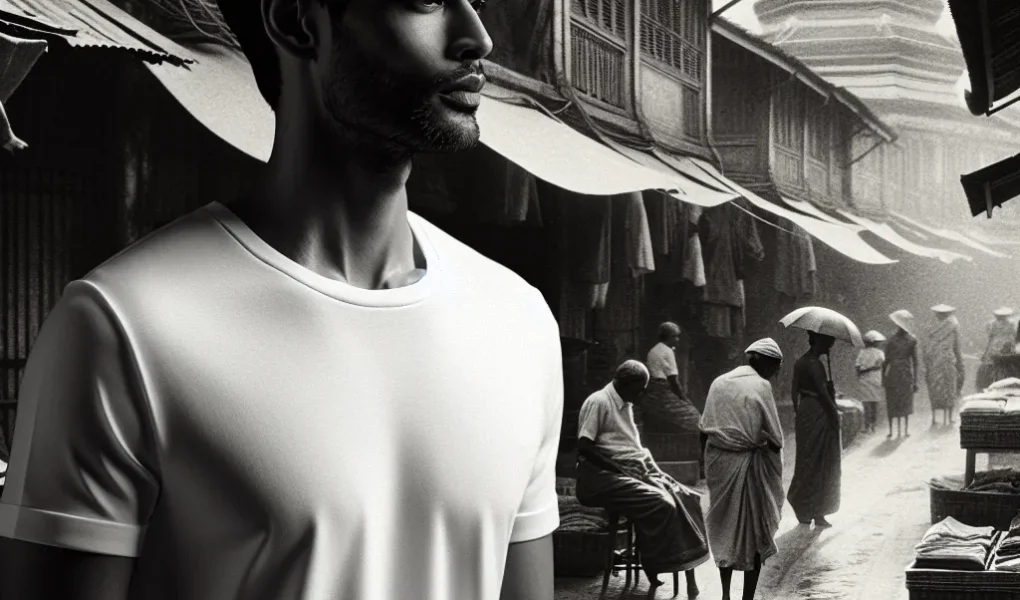The History of T-shirts: From Undergarment to Iconic Fashion Staple
The history of T-shirts dates back to the late 19th century when they were introduced as an undergarment for laborers in the United States Navy. These simple, short-sleeved, crew-necked shirts were designed to be lightweight, breathable, and easy to clean, making them an ideal choice for men working in hot and physically demanding conditions.
It wasn’t until the early 20th century that the T-shirt started to gain popularity beyond its original function. In the 1950s, iconic figures like Marlon Brando and James Dean sported T-shirts on the big screen, propelling the garment into the realm of casual fashion. The association with rebelliousness and non-conformity further solidified the T-shirt’s status as a cultural symbol.
As the decades passed, T-shirts continued to evolve, becoming a means of self-expression and a canvas for artistic and political statements. The 1960s and 1970s saw the rise of graphic tees, often featuring bold designs and slogans that reflected the social and political climate of the time.
Today, T-shirts have solidified their place in the fashion world as a versatile and iconic wardrobe staple. From basic white tees to designer collaborations and limited-edition releases, the T-shirt has come a long way from its humble beginnings as an undergarment for sailors to a symbol of self-expression, cultural significance, and individual style.
The Cultural Impact of T-shirts: How a Simple Garment Redefined Style
As the T-shirt has evolved from a functional undergarment to a fashion staple, its cultural impact cannot be overlooked. What was once considered an item of basic clothing primarily worn as an undergarment has now become a powerful form of self-expression and a canvas for personal and social statements. The simplicity and versatility of the T-shirt have allowed it to transcend cultural and social boundaries, making it a universal symbol of style and individuality.
The cultural impact of T-shirts can be seen in their association with various movements and causes. From band merchandise to political slogans, T-shirts have been used to express solidarity and to convey powerful messages. The T-shirt has become a medium for cultural and social commentary, allowing individuals to showcase their affiliations, beliefs, and identities.
Furthermore, the democratization of fashion brought about by T-shirts has reshaped the industry and challenged traditional notions of style and class. T-shirts have become a equalizing force, blurring the lines between high fashion and streetwear. Designers and brands have embraced the T-shirt as a blank canvas for artistic expression, leading to collaborations and collections that bridge the gap between luxury and everyday wear.
In conclusion, the cultural impact of T-shirts is undeniable. From its humble origins as an undergarment to its current status as a fashion statement, the T-shirt has redefined style and become a symbol of cultural movements and individual expression.
The Evolution of T-shirts: Exploring the Intersection of Comfort and Style
The evolution of T-shirts has transformed them from just being functional wear to making a powerful fashion statement. This evolution explores the intersection of comfort and style, as T-shirts have become an essential wardrobe staple for people of all ages and backgrounds. The comfort of a T-shirt lies in its soft, breathable fabric that allows for ease of movement and relaxation. This functional aspect has been retained and enhanced over time, with the use of innovative materials and technology.
On the other hand, the style evolution of T-shirts has been remarkable. What was once considered an undergarment or basic workwear has now become a versatile fashion piece. T-shirts are no longer confined to plain colors and simple designs; they now feature intricate artwork, bold statements, and creative embellishments. The intersection of comfort and style is evident in the diverse range of T-shirts available, catering to various preferences and occasions.
Moreover, the evolution of T-shirts has also been influenced by cultural and social movements. Graphic tees are often used as a canvas for expressing individual beliefs, affiliations, and interests. This intersection of comfort and style is seen in the way T-shirts can be a form of self-expression while providing the ease of wear for everyday activities.
In conclusion, the evolution of T-shirts has seamlessly integrated comfort and style, making them an iconic garment in fashion history. The ability to balance functionality with fashion has cemented the T-shirt’s position as a timeless clothing item.
T-shirts through the Decades: A Fashion Journey from Basic to Bold
Throughout the decades, T-shirts have evolved from being functional wear to making a bold fashion statement. This evolution has reflected the changing trends and social norms of each era, shaping the way T-shirts are perceived and worn today.
In the early 20th century, T-shirts were primarily used as an undergarment, with their simple, basic design serving a purely functional purpose. It wasn’t until the 1950s that T-shirts started to transition into a standalone fashion piece, popularized by icons like Marlon Brando and James Dean, who wore them as outerwear in classic films.
The 1960s and 1970s saw T-shirts become a canvas for self-expression, with tie-dye, band logos, and bold graphics becoming popular. This trend continued into the 1980s, where T-shirts became synonymous with conveying personal beliefs and affiliations, such as the iconic “Frankie Says Relax” and political slogan tees.
As the 21st century dawned, T-shirts underwent a renaissance, with designers incorporating luxurious fabrics, intricate designs, and innovative cuts, elevating the once-basic T-shirt to high fashion status. This transformation has led to T-shirts being embraced as a versatile garment that can be styled for casual, business, and even formal occasions.
Today, T-shirts have become a staple in wardrobes worldwide, offering endless possibilities for self-expression and style. From basic white tees to bold, statement-making designs, the evolution of T-shirts as a fashion journey has truly been remarkable.
Reinventing Tradition: Modern Trends in T-shirt Design
Modern trends in t-shirt design have reinvented the traditional function of this garment, transforming it from basic attire to a powerful fashion statement. T-shirts have evolved from simple, utilitarian undergarments to versatile pieces that reflect individual style and cultural trends. Contemporary t-shirt design incorporates a wide range of techniques, such as screen printing, embroidery, and innovative fabric blends, allowing for limitless creativity and personal expression.
One of the prominent modern trends in t-shirt design is the incorporation of bold graphic elements and striking visuals. This trend embraces the use of eye-catching imagery, intricate patterns, and thought-provoking slogans, making t-shirts a canvas for artistic expression. Additionally, the shift towards sustainable and eco-friendly practices has influenced t-shirt design, leading to the use of organic cotton, bamboo fibers, and water-based dyes, aligning fashion with environmental consciousness.
Furthermore, the concept of personalized and custom-designed t-shirts has gained significant popularity in recent years. With the advancement of digital printing technology, individuals can now create unique t-shirt designs that reflect their personality, interests, and affiliations. This customization trend has given rise to a sense of individuality, empowering people to wear t-shirts that resonate with their personal narratives.



